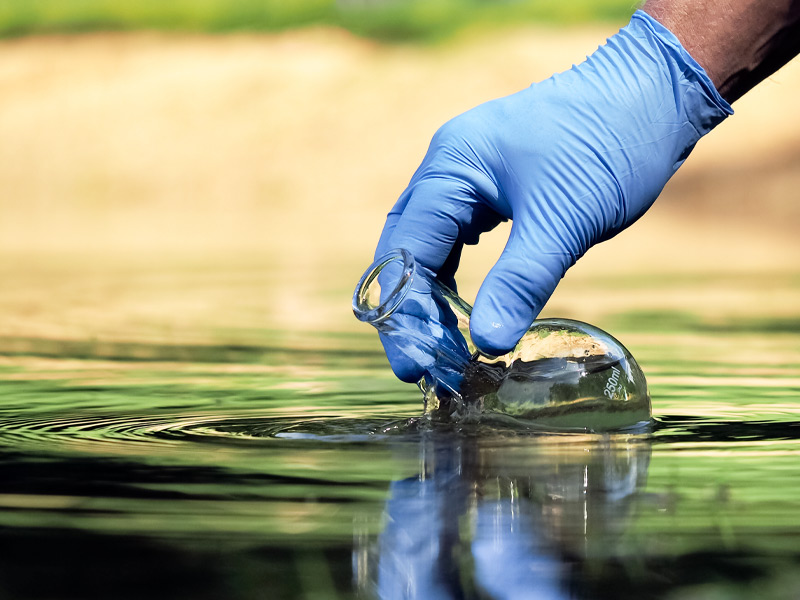Training Center
Now Is the Time to Test Your Water
Thursday, September 7, 2023 | Ed Bloodnick

Irrigation in greenhouses can be a major challenge for some managers because water supply and water quality can considerably affect the success of the crop. However, regular water analysis is not always a common practice in many greenhouses.
Considering that water may be coming from many sources throughout the year, there can be variability in quality. That's why it is important to look in a water analysis.
The water provided by municipalities, ponds and wells can have variable chemistry throughout the year: after snow melts, in the summer drought, or after heavy rainfall. Why is this important? Water quality can impact a growing medium's pH because of high or low water alkalinity.
Therefore, a periodic water sampling and analysis program will keep tabs on the minerals or nutrients present in the water and which can affect a growing medium's pH and fertilizer availability for plants.
What’s most important to look for in a water analysis?
1- Water Alkalinity and pH
Water contains bicarbonates and carbonates, measured as the alkalinity of water, which will affect the pH of the growing medium. Bicarbonates and carbonates are bonded with calcium, magnesium, sodium and/or other ions dissolved in the irrigation water. Alkalinity is expressed in ppm (parts per million) of calcium carbonate (CaCO3) and impacts a growing medium's pH over time.
The pH of the water source is irrelevant and has no impact on a growing medium's pH over time. However, pH is important to monitor since it will affect the solubility of the fertilizers and other chemicals applied.
When water alkalinity is high, the growing medium will receive a lot of carbonates and bicarbonates, much like adding limestone, which will cause the growing medium's pH to rise. If no corrective actions are taken to reduce the alkalinity, the growing medium's pH will rise. This can lead to problems in nutrient availability, particularly iron and manganese, which are less soluble in a growing medium pH greater than 6. Plants prone to iron deficiency will show yellowing on the newly formed leaves.
Low water alkalinity can be a problem as well and needs to be monitored regularly. As a corrective measure, some potential basic fertilizers do provide ingredients to raise pH, such as nitrate fertilizers. However, if the alkalinity is very low, these fertilizers may not be adequate to correct pH and the growing medium's pH will be too acidic. Flowable limestone is a good corrective measure if the growing medium's pH is a half unit below ideal range.
2- Minerals and Electrical Conductivity
The electrical conductivity (EC) tells you the total elemental content of the water and is useful in choosing the right fertilizers. EC and pH tests can be provided by commercial labs or can be measured on a regular basis with portable metres at your greenhouse. If you use portable equipment, remember to calibrate it before each use to be sure your measurements are accurate.
Recycling Water
Many greenhouses have environmental restrictions which oblige them to limit the amount of water they can use, so water is often collected and recycled. In this case, water testing must be done on a frequent basis and water sanitation becomes an issue because harmful microbes, such as Pythium, will persist if proper sanitizing methods are not are used.
The water source(s) should be analyzed to determine water chemistry and look for algae, pesticide residue and plant or human pathogens. Most recycling systems have filters that remove large particles. Sanitation equipment that uses UV rays, copper ionization or ozone can then be used to control pathogens.
How to understand the water analysis results and what to look for?
See below a typical water analysis from a greenhouse. As you can see, not all laboratory results supply information regarding the nutrient levels or alkalinity that need corrective measures.
Helpful guidelines:
- EC > 0.8 mmhos/cm
- Alkalinity is high when it’s over 150 ppm (CaCO3). To correct this, either use potentially acidic fertilizers or inject acid into the water to reduce alkalinity to a desirable range. Alkalinity below 40 ppm (CaCO3) is low, therefore use fertilizers with no or low ammoniacal nitrogen. Another option is to have your growing media manufacturer increase the buffering capacity with limestone.
- Calcium > 40 ppm. If not, calcium will be deficient. To correct this, use fertilizers with Calcium if water has a low alkalinity.
- Magnesium > 20 ppm. If not, use Epsom salts or fertilizers with magnesium.
- Sulfate > 75 ppm
- Boron < 0.5 ppm
- Chloride < 50 ppm
- Sodium < 50 ppm
| Example of water analysis | |
| pH | 7.60 |
| EC (mmhos/cm) | 0.80 (ppm) |
| Nitrate Nitrogen | 7.00 |
| Ammonium - N | < .5 |
| Phosphorus | <1 |
| Potassium | 6.37 |
| Calcium | 65.28 |
| Magnesium | 43.75 |
| Bicarbonate | 207.00 |
| Alkalinity | 165.60 |
| Chloride | 8.00 |
| Sulphates | 238.60 |
| Sodium | 39.36 |
| Zinc | 0.06 |
| Manganese | 0.01 |
| Copper | 0.01 |
| Iron | 0.01 |
| Boron | 0.14 |
| Molybdenum | < .01 |
| Silicon | 5.13 |
| Cations | 8.78 |
| Anions | 9.08 |
For more information on how to control water alkalinity, consult the following link for access to a calculator that evaluates the amount of acid to correct high alkalinity:
http://extension.unh.edu/Agric/AGGHFL/alk_calc.cfm
 |
 |
 |
 |
|---|---|---|---|
|
Ed Bloodnick |
Nathan Wallace-Springer |
Lance Lawson |
Victor Brantly |
 |
 |
 |
|
|
Troy Buechel |
Susan Parent |
Jose Chen Lopez |
PRO-MIX® is a registered trademark of PREMIER HORTICULTURE Ltd.

 Where to find our products
Where to find our products
